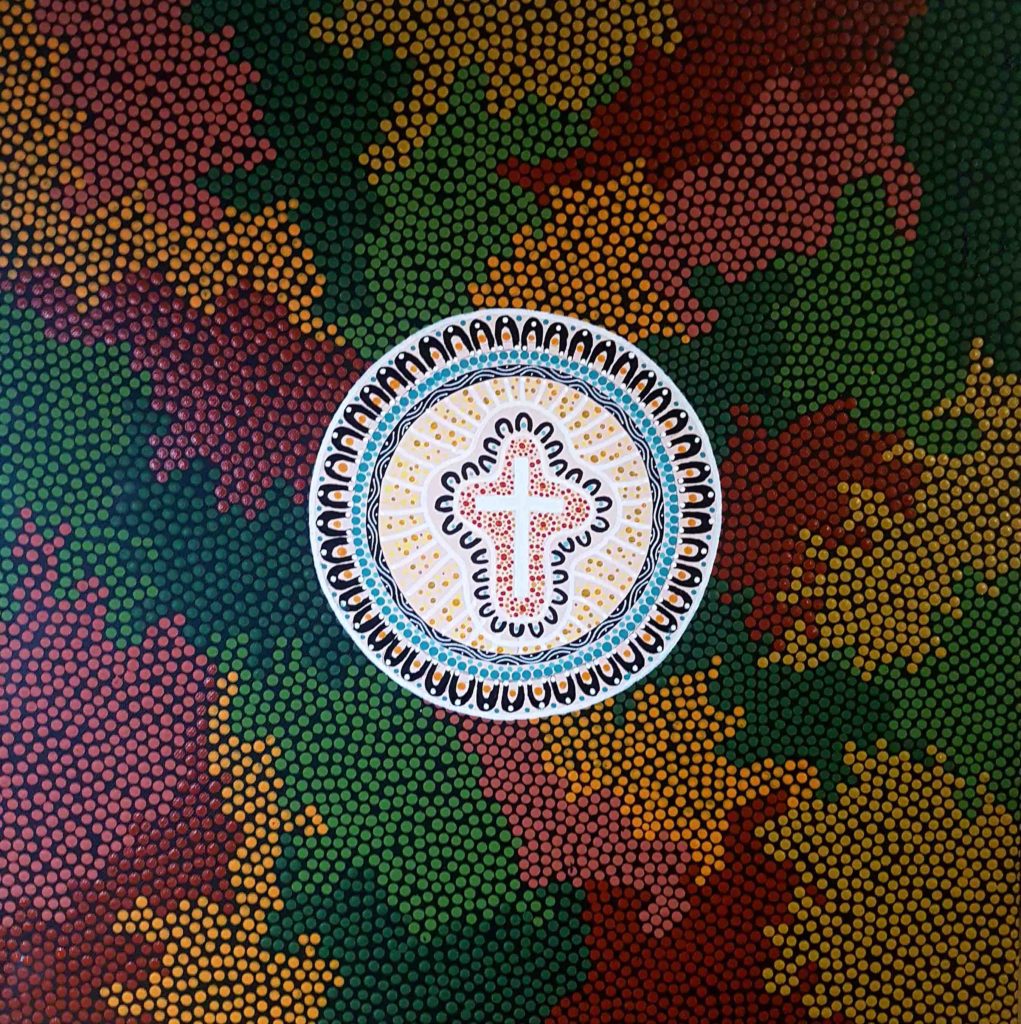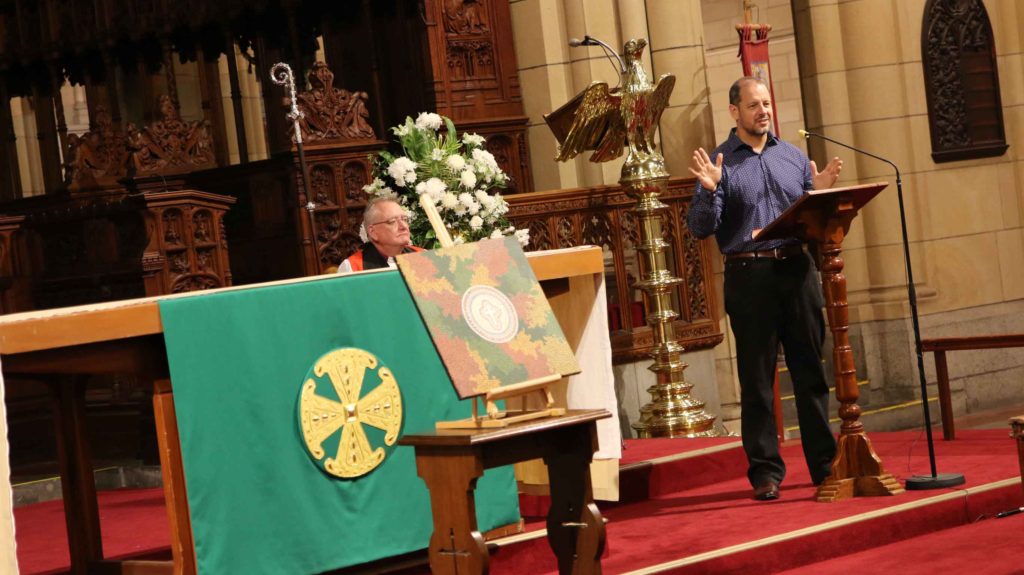Ancient Aboriginal practice meets Divine Christian call
News
A stunning Aboriginal dot painting has been commissioned to commemorate Archbishop Phillip Aspinall’s 2020-2022 Diocesan ‘Being Together’ theme, fittingly upholding our community’s commitment to Reconciliation and our call as a Church to seek unity and holiness

Story Timeline
Reconciliation Action Plan achievements
- Pilgrimage to Wontulp-Bi-Buya (WBB) College
- St Mark’s supporting First Nations constitutional reform
- New Anglicare SQ cards further Reconciliation journey
- PATSIMAC group creating welcome and honouring the culture of the Yugambeh people
- Anglicare’s Reconciling Histories project
- Reconciliation: relationships and respect
- Reconciliation Prayer Spaces
- SEQ Friends of Nungalinya College – building cultural bridges
- Exploring mission in a post-colonial Australian church
- First Nations ‘icons’ – a portal to Aboriginal and Torres Strait Islander Spiritualities
- Stunning Aboriginal dot paintings to travel around our Diocese
A stunning Aboriginal dot painting has been commissioned by the Parish and Other Mission Agencies Commission (PMC) to commemorate Archbishop Phillip Aspinall’s 2020-2022 Diocesan theme, fittingly upholding our community’s commitment to Reconciliation and our Christian call to seek unity and holiness.
The painting, entitled ‘Being Together’, was created by talented emerging artist Stevie O’Chin, who belongs to the Kabi Kabi and Koa peoples on her father’s side and the Yuin people on her mother’s side.
Stevie O’Chin said that she was particularly inspired by the seventh Diocesan Mark of Mission ‘to live as one holy catholic and apostolic Church’, which is represented by the intricate circle in the centre of the artwork.
“Each circle has ‘U shapes’ that surround the symbols – these symbolise people gathering together to worship, and the blue dotted rings around each symbol in the circles mark the spiritual healing power of God,” Ms O’Chin said.
“What inspired this piece of artwork is what the mission stands for…the mission’s holistic approach…and wanting to make a difference for the betterment of humankind in this country.”
Ms O’Chin said that she carefully considered all elements of the ‘Being Together’ work, which evolved organically during the process of its creation.
“Much thought went into this piece, from design, pattern and the colour scheme, and I find that while reflecting on the piece of art I’m designing, it constantly changes and evolves once I start applying paint to the canvas.”

Artist Stevie O’Chin said that she was particularly inspired by the seventh Diocesan Mark of Mission ‘to live as one holy catholic and apostolic Church’, which is represented by the intricate circle in the centre of the artwork: “Each circle has ‘U shapes’ that surround the symbols – these symbolise people gathering together to worship, and the blue dotted rings around each symbol in the circles mark the spiritual healing power of God”
Archbishop Phillip Aspinall said that ‘to live as one holy catholic and apostolic Church’ harks back to an ecumenical creed with an emphasis on unity and holiness, and he encourages us to share our ‘Being Together’ stories with him.
“One of the marks of mission of our Diocese is ‘to live as one holy catholic and apostolic Church’, which is based on the Nicene Creed,” Archbishop Aspinall said.
“ ‘Catholic’ comes from the Greek kata meaning ‘according to’ and holos meaning ‘whole’ or ‘all’. So, part of our mission is to live in unity and holiness in accordance with the whole church.
Advertisement
“John 17.20-24 tells us that Jesus desires unity among his disciples, just as he and God the Father are one, so that the world will believe that the Father sent Jesus.
“To be one is our divine calling and goes to the heart of our mission. This is so regardless of real or perceived differences among us.
“As we explore ‘Being Together’ over the next three years, I hope that we embrace the call ‘to live as one holy catholic and apostolic Church’. Christ’s mission to the world, our mission, depends on it.
“I look forward to hearing about how you explore ‘Being Together’ and the fruit it bears.”
Dot painting is one of the most internationally recognised forms of Aboriginal First Nations art.
It is an ancient and deeply symbolic practice of the world’s oldest continuously living culture that started with sand, soil and body ‘canvases’, with First Nations artists commencing dot painting on framed stretched canvases in the 1970s.
Ms O’Chin said that she carries on a family legacy of Aboriginal dot painting.
Advertisement
“My paintings are inspired by my surroundings and stories told to me by my parents and family elders,” she said.
“I hail from a large family, many of who are artists, from both my parents’ sides, and I was influenced from a young age and was self-taught from watching my family.
“I am very happy with the result of each artwork; I feel like everything is positioned in the right place and tells the story perfectly.”
The Anglican Church Southern Queensland’s Reconciliation Action Plan (RAP) states that:
“Reconciliation is specifically identified as a key imperative within the Fourth Mark of Mission of the Anglican Communion, as part of God’s Transformation of our lives and all of Creation. Indeed, within Australian contexts, it is hard to see how justice can be done to any of the five international Marks of Mission without adequate attention and will being brought to Indigenous reconciliation issues (p. 3).”
PMC Executive Director and RAP Working Group member Stephen Harrison said that Aboriginal dot painting was chosen as the medium for the artwork to, both, tangibly commemorate the 2020-2022 Diocesan theme’s richness and to uphold the principles and ‘Actions’ of our RAP, which our whole Diocesan community is committed to.
“The timeless practice of Aboriginal dot painting symbolically communicates the depth of the 2020-2022 ‘Being Together’ theme in profound and multi-layered ways,” Dr Harrison said.
“By commissioning dot paintings for the commemoration of our 2020-2022 annual theme, the RAP’s ‘Actions’ to ‘engage diocese, schools and Anglicare staff in understanding and appreciating Aboriginal and Torres Strait Islander cultures, histories and achievements (p.13)’ and to ‘incorporate Aboriginal and Torres Strait Islander supplier diversity within the Church (p. 16)’ are formally embedded in our Diocesan-wide strategies and practices.”
Dr Harrison introduced the intricate ‘Being Together’ dot painting to our Diocesan community at the launch event for the Archbishop’s 2020 ‘Being Together: Practising Peacemaking’ theme in February during a moving service in St John’s Cathedral.

Stephen Harrison introduced the intricate ‘Being Together’ dot painting to our Diocesan community at the launch event for the Archbishop’s 2020 ‘Being Together: Practising Peacemaking’ theme in February during a moving service in St John’s Cathedral






